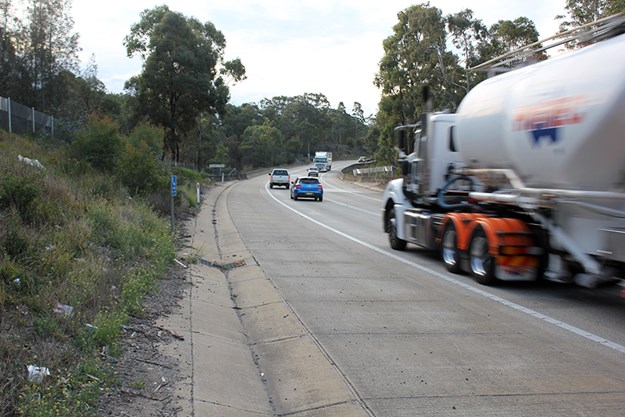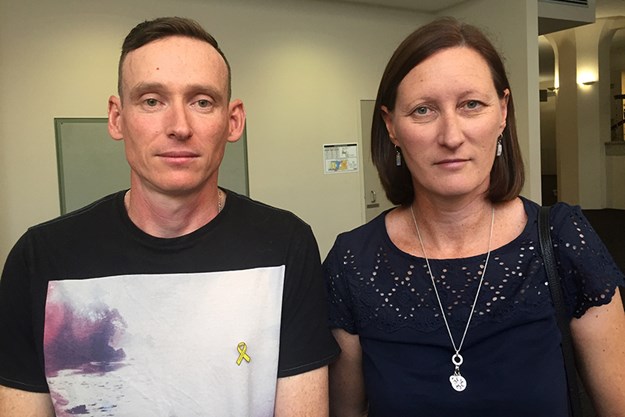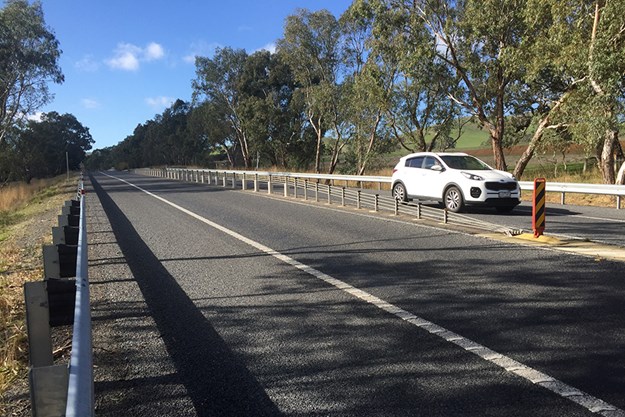Road authorities are installing more centre barriers on busy roads around Australia, but how well do they work in preventing head-on crashes?
 |
|
Cars and trucks mingling at 100km/h with little margin for error on busy Picton Road near Wilton in NSW
|
It was just like any other early morning on the Hume Motorway for the stream of trucks heading towards the southern outskirts of Sydney after a long night driving from Melbourne.
Not much CB radio chatter because most drivers were too tired to talk; finally some good reception for FM music stations; and cars were jostling for freeway space as they began their long commutes towards the city, after merging from major side-roads.
Then shortly after 5am on March 24, 2017, near Wilton, 80 kilometres from the Sydney CBD, everything suddenly changed.
First the CB lit up with talk of a head-on truck crash nearby on the very busy Picton Road, a major state arterial between Sydney and Wollongong. Then the flashing lights and sirens of numerous police and emergency vehicles could be seen and heard on the opposite side of the freeway heading south.
A car-carrier driven by Michael Gorman, 39, and a bulk haulage combination driven by Adrian Ryan, 32, had collided just a few kilometres from the intersection with the freeway, not long after both drivers had started their work for the day.
They were just two of seven people killed in five separate head-on accidents on a deadly six kilometre stretch of Picton Road over four years to the end of 2018.
In November 2018 the driver of a light truck died in a head-on crash with a car carrier, whose driver was trapped for 90 minutes before being airlifted to hospital.
Yet at the time of writing more than a year after the most recent fatality, there are still no centre-line concrete barriers, steel railings, wire ropes or even wide centre line markings along most of the six kilometre stretch of 100km/h state road.
That’s despite the fact that more than 20,000 vehicles a day use Picton Road, a quarter of them heavy vehicles. Truck traffic is projected to increase at roughly 7 per cent a year.
“I think it’s appalling,” says Mark Gorman, brother of Michael. “They’ve got the statistics there, you can see what’s happening, but they just turn a blind eye to it.
“For the amount of cars and heavy vehicles that use that road, something has to be done.”
National Priority
There are many other Picton Road-type situations across Australia.
On average nearly 20 per cent of the roughly 1,200 Australians killed in road crashes each year over the past few years have died in head-ons.
 |
|
Centre barrier fan: David McTiernan from the Australian Road Research Board. Photo: ARRB
|
Meanwhile the majority of road fatalities are in regional areas, despite only a minority of the population living in the regions.
Put these figures together and it’s no surprise that the independent government advisory body, Infrastructure Australia (IA), lists ‘regional road network safety improvements’ as a high priority.
It says infrastructure such as safety barriers helps avoid head-on crashes, and reduces the severity of crashes if they do happen.
The Australian Road Research Board (ARRB) agrees.
“Centre barriers are saving lives,” says David McTiernan, national leader, transport safety, with ARRB.
“From a truckie’s point of view, it’s usually not the truck’s fault that someone drives into their lane. A median barrier is there to try and protect the person who has made the mistake but also the innocent people – the truckies or a family coming the other way.”
McTiernan says each type of barrier has its pros and cons.
High reinforced concrete barriers can stop trucks crossing to the wrong side, but they are unforgiving to occupants of a car which may hit them, and likely to cause a car to roll. They are the most expensive type of barrier, but also involve the least maintenance.
Flexible wire rope barriers are not designed to stop trucks from ending up on the wrong side, but they stop cars, and their flexibility means car occupants are less likely to be killed or injured compared with rigid barriers. They can be cheaper and are more flexible than steel guardrails, however because the posts are designed to bend over when they are hit, these posts need replacing.
McTiernan says there are often many other “balancing acts” with barriers, including trading off roadside shoulder width for the necessary centre width to install a barrier.
How much are lives worth?
Of course the ideal solution for preventing head-ons is to have divided dual-lane carriageways.
The NSW Government says the 80 per cent duplication so far of the Pacific Highway between Newcastle and the Queensland border has seen a 50 per cent reduction in fatal crashes.
 |
|
The scene of the tragic truck crash on Picton Road in 2017.
|
The Illawarra Business Chamber and NRMA (National Roads and Motorists’ Association) are lobbying for Picton Road to be converted to a divided dual lane by 2025. This is for both safety reasons and to cope with the rapidly growing traffic and freight task. The organisations say there will be major economic benefits.
Their 2018 report estimated the cost of that to be about $200 million for the 24 kilometres involved, but that seems highly optimistic compared with other figures Owner//Driver has seen.
At the Wollongong end of Picton Road, more than $50 million worth of roadworks went in quite a few years ago, including straightening bends; putting in more overtaking lanes; and installing concrete centre barriers.
Perhaps it’s no coincidence, then, that according to the local Illawarra Mercury newspaper, there haven’t been any fatalities on that stretch of road since the works were completed in 2014.
 |
|
Another fatal stretch of Picton Road near Wilton, with no centre safety barrier and no overtaking lane
|
At the spot where the double fatal truck crash happened in 2017, it would be difficult to install any sort of centre barrier, because it’s currently a narrow cutting leading onto a single lane bridge over Allens Creek.
But as far as Mark Gorman is concerned, that’s no reason to do nothing. “I don’t know why they can’t widen the bridge and put a barrier down the middle,” he says.
Mark lives in nearby Camden, from where a lot of young people drive to university in Wollongong and to the beach.
“I wouldn’t like my kids driving down there, how Picton Road is at the moment. Absolutely not,” he says.
IA is also concerned about Picton Road.
“The volume of passenger and heavy vehicles on Picton Road, combined with difficult topography, is causing significant delays and safety issues on the route. This is resulting in longer travel times and high crash rates,” says an IA report.
“Traffic volumes are expected to grow along the corridor with population growth, development in Western Sydney and growth at Port Kembla.”
 |
|
“Something has to be done”: NSW truck driver Michael Gorman’s brother Mark and sister Sharon
|
That development in Western Sydney includes Sydney’s second airport at Badgery’s Creek; and the growth at Port Kembla includes the Sydney region’s only port for car-carrying ships since Sydney’s White Bay was closed to car carriers a decade ago.
Not to mention the Wilton Growth Area around the junction of the Hume Motorway and Picton Road, which is planned to house 50,000 people over the next two or three decades.
According to Infrastructure Australia, nearer-term options include “minor road upgrades” such as providing central barriers, upgrading intersections and more overtaking opportunities.
McTiernan says: “Picton Road needs to be developed to reflect the level of importance that it has, particularly in moving freight between the Illawarra and Sydney and the Hume Highway.
“There definitely needs to be some investment in it, and the State Government is certainly doing that, but the pace of it is obviously something that might be of concern to the community.
“That six-kilometre stretch requires widening if it’s going to effective from a road safety and a traffic management point of view. You need an overtaking lane and that may be part of the hold-up.”
Local Wilton MP, Member for Wollondilly Nathaniel Smith, did not respond to Owner//Driver’s requests for comment on short- or long-term NSW Government plans for the horror six-kilometre stretch.
Victorian barriers controversy
The Victorian Government has one of the biggest flexible safety barrier programs in Australia.
Its ‘Towards Zero’ website says the posts and cables are made in Australia and cost about $80 a metre to supply and install – that’s about $80,000 a kilometre.
 |
|
A flexible wire barrier being installed in Victoria. Photo: Towards Zero
|
The posts are spaced closer when the hazard is close to the barrier. If you look up videos on the internet you can see there can be enough “give” in the system for a car to continue well into the lane on the wrong side of the road before the ropes deflect it back. However a crash with another vehicle would more likely be a side-swipe rather than a head-on, and therefore its severity would be reduced.
“During impact, the posts bend close to the ground, and the ropes release from the post assisting the vehicle to divert excessive force and slow down,” the website says.
The barriers have been tested for cars and light trucks – but not big trucks.
Apart from being an unknown quantity for big trucks, wire barriers are not the be-all and end-all for safety: they can create their own problems.
For example as many truckies know, barriers are often so close to the fog-line that there is no room for a car to pull up safely off the road if it breaks down, let alone a truck.
Opposition MPs in rural Victoria have been critical of the Victorian Government’s flexible wire barrier program, saying much of it has been installed in inappropriate places.
Their complaints include emergency services having to drive too far to find a gap in the middle to get across to the opposite side.
 |
|
Side steel guardrail and flexible wire centre barrier on a rural Victorian road
|
Perhaps that’s why in announcing the completion of new works on a stretch of the Western Freeway between Melbourne and Ballarat, the Victorian Government said this of flexible safety barriers: “The new barriers also include additional turning points for emergency services and access breaks from every 500m to 1km that allow cars space to pull over during breakdowns and emergencies.”
The September 2019 media release also said: “The improvements will significantly improve safety along the Western Freeway and reduce the risk and severity of head-on and run-off-road crashes.
“Existing safety barriers on the Western Freeway were hit 236 times in 2018 – which is 236 potentially serious crashes avoided.”
Meanwhile the Victorian Auditor-General’s Office is looking into whether Victoria’s regional road barriers program is delivering the intended safety outcomes on the high risk, high volume and high speed roads on which it is being rolled out.
The Auditor-General’s website says that in 2016, fatalities were four times more likely on regional than metropolitan roads.
“These crashes are primarily head-on collisions or collisions with roadside objects such as trees,” it says.
“Research has shown that flexible safety barriers can reduce these types of crashes by up to 85 per cent. In 2018, the number of road crash fatalities fell by 17 per cent from the previous year and fatalities on high-speed regional roads reduced by 44 per cent.
“Despite the fall in 2018 of road crash fatalities on high-speed regional roads, regional road safety barriers have received significant media attention because of their high visibility and a range of concerns,” says the A-G’s Office.
“Some stakeholders are concerned that the barriers may not be as effective as the Victorian Government claims, and that they may exacerbate injuries for motorcyclists.”

